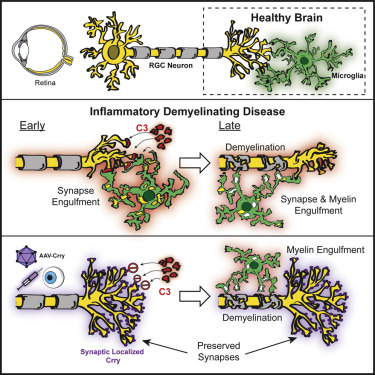Our official English website, www.x-mol.net, welcomes your
feedback! (Note: you will need to create a separate account there.)
Targeted Complement Inhibition at Synapses Prevents Microglial Synaptic Engulfment and Synapse Loss in Demyelinating Disease.
Immunity ( IF 25.5 ) Pub Date : 2019-12-23 , DOI: 10.1016/j.immuni.2019.12.004 Sebastian Werneburg 1 , Jonathan Jung 1 , Rejani B Kunjamma 2 , Seung-Kwon Ha 3 , Nicholas J Luciano 3 , Cory M Willis 4 , Guangping Gao 5 , Natalia P Biscola 6 , Leif A Havton 7 , Stephen J Crocker 4 , Brian Popko 2 , Daniel S Reich 3 , Dorothy P Schafer 1
Immunity ( IF 25.5 ) Pub Date : 2019-12-23 , DOI: 10.1016/j.immuni.2019.12.004 Sebastian Werneburg 1 , Jonathan Jung 1 , Rejani B Kunjamma 2 , Seung-Kwon Ha 3 , Nicholas J Luciano 3 , Cory M Willis 4 , Guangping Gao 5 , Natalia P Biscola 6 , Leif A Havton 7 , Stephen J Crocker 4 , Brian Popko 2 , Daniel S Reich 3 , Dorothy P Schafer 1
Affiliation

|
Multiple sclerosis (MS) is a demyelinating, autoimmune disease of the central nervous system. While work has focused on myelin and axon loss in MS, less is known about mechanisms underlying synaptic changes. Using postmortem human MS tissue, a preclinical nonhuman primate model of MS, and two rodent models of demyelinating disease, we investigated synapse changes in the visual system. Similar to other neurodegenerative diseases, microglial synaptic engulfment and profound synapse loss were observed. In mice, synapse loss occurred independently of local demyelination and neuronal degeneration but coincided with gliosis and increased complement component C3, but not C1q, at synapses. Viral overexpression of the complement inhibitor Crry at C3-bound synapses decreased microglial engulfment of synapses and protected visual function. These results indicate that microglia eliminate synapses through the alternative complement cascade in demyelinating disease and identify a strategy to prevent synapse loss that may be broadly applicable to other neurodegenerative diseases. VIDEO ABSTRACT.
中文翻译:

突触的靶向补体抑制可防止脱髓鞘疾病中的小胶质细胞突触吞噬和突触损失。
多发性硬化症 (MS) 是一种中枢神经系统脱髓鞘自身免疫性疾病。虽然工作重点是多发性硬化症中的髓磷脂和轴突损失,但人们对突触变化的机制知之甚少。我们使用死后的人类多发性硬化症组织、多发性硬化症的临床前非人灵长类动物模型和两种脱髓鞘疾病的啮齿动物模型,研究了视觉系统中的突触变化。与其他神经退行性疾病类似,观察到小胶质细胞突触吞噬和严重突触损失。在小鼠中,突触损失的发生与局部脱髓鞘和神经元变性无关,但与突触处的神经胶质增生和补体成分 C3(但不是 C1q)增加同时发生。C3 结合突触补体抑制剂 Crry 的病毒过度表达减少了小胶质细胞对突触的吞噬并保护了视觉功能。这些结果表明,小胶质细胞通过脱髓鞘疾病中的替代补体级联消除突触,并确定了一种预防突触丢失的策略,该策略可能广泛适用于其他神经退行性疾病。视频摘要。
更新日期:2019-12-27
中文翻译:

突触的靶向补体抑制可防止脱髓鞘疾病中的小胶质细胞突触吞噬和突触损失。
多发性硬化症 (MS) 是一种中枢神经系统脱髓鞘自身免疫性疾病。虽然工作重点是多发性硬化症中的髓磷脂和轴突损失,但人们对突触变化的机制知之甚少。我们使用死后的人类多发性硬化症组织、多发性硬化症的临床前非人灵长类动物模型和两种脱髓鞘疾病的啮齿动物模型,研究了视觉系统中的突触变化。与其他神经退行性疾病类似,观察到小胶质细胞突触吞噬和严重突触损失。在小鼠中,突触损失的发生与局部脱髓鞘和神经元变性无关,但与突触处的神经胶质增生和补体成分 C3(但不是 C1q)增加同时发生。C3 结合突触补体抑制剂 Crry 的病毒过度表达减少了小胶质细胞对突触的吞噬并保护了视觉功能。这些结果表明,小胶质细胞通过脱髓鞘疾病中的替代补体级联消除突触,并确定了一种预防突触丢失的策略,该策略可能广泛适用于其他神经退行性疾病。视频摘要。











































 京公网安备 11010802027423号
京公网安备 11010802027423号